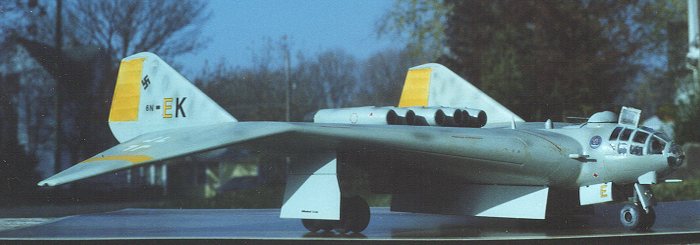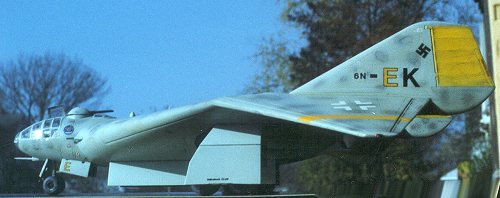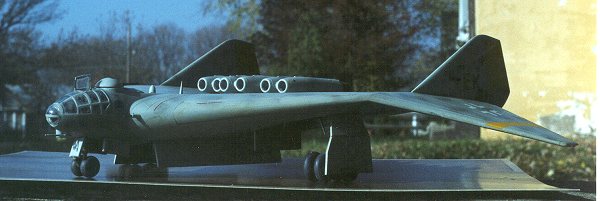
|
KIT: |
Revell Germany 1/72 Arado E.555 |
|
KIT # |
4367 |
|
PRICE: |
$16.50 |
|
DECALS: |
Two versions: Generic German |
|
REVIEW BY: |
|
|
NOTES: |
No swastika |

|
HISTORY |
Rain freckled the windscreen of the big Arado as it slid quietly through the August night its six BMW turbojets still functioning smoothly, thank
God. Its pilot, Oberst Hans "Hairy" Wiemann, was lost in thought. What would he tell the new Fuhrer? How could he explain the failure of his
mission, a mission that had started out that very morning with so much
hope, so much promise?
He and the three other members of his flight had taken off at first light from their airfield right outside of Brest, France. Climbing
smoothly and slowly to 14,000 meters, they had set off on a northwesterly heading. At that altitude, the jets performed most
efficiently at their cruising speed of 715 km/hr. They had only gone about 100 km when their escort of Messerschmitt P. 1099's had turned
around, heading back to Brest.
Several hours later they had touched down safely at the secret airfield/U-Boat refueling station that had been established in southern
Greenland. Here they off-loaded the auxiliary fuel tanks that had been taking up much of the bomb bay space and exchanged them for two 1000 kg
and three 500 kg bombs. These bombs had been brought to the base by U-Boats in a series of supply runs over the preceding six months.
The "Black Men" had quickly and efficiently loaded the bombs and refueled the aircraft while the crews had a quick meal and a cup of hot
tea. Again takeoff had been without incident. It was then that Wiemann had announced to the other three aircraft and his own crew their target,
New York! Now the heading had been southwest.
After some time at altitude, Wiemann had radioed all aircraft to begin descending to 100 meters altitude. By his estimation, they were only
100 km from New York and he wanted to sneak in under the enemy's radar. They had been at that altitude for less than 5 minutes when they had
passed over some small warships steaming slowly eastward. Luckily, the ships had not fired a shot at the fast moving Arados. Perhaps they had
not been seen! Luck and surprise seemed to be on their side.
Only five minutes later, those hopes sank as the planes passed over what appeared to be a full armada of enemy ships, an armada that had included
at least two aircraft carriers! This time the whole fleet opened up with every antiaircraft gun they had. Luckily, the planes were going
too fast for the gunners to be able to adjust their lead effectively.
No sooner had they cleared the ships thought than, without warning, they were set upon by a swarm of long-nosed, radial-engined, bent-winged
aircraft. These planes were obviously the American Navy's Corsairs, but of a new type never before seen. They were fast! Faster than any
aircraft that Wiemann had ever seen trying to fly so close to sea
level. One of his pilots, the youngest, had panicked, shoving his throttles forward too fast. The delicate jet engines had been unable to
accept the quick throttle movements and at least half of the six engines had flamed out. The Corsairs had been on him in an instant, long flames
from their 20mm cannon spurting from their wings as they fired. It was over in an instant; the unfortunate Arado exploded on impact with the
Atlantic. The three crewmen never had a chance to get out.
Wiemann's own gunner, Feldwebel Schultz, had handled the rear and top turret 151/20 cannon masterfully driving off every attacker and even
claiming to have flamed two Corsairs before they finally pulled away from those accursed interceptors. Quickly, Wiemann had ordered the
surviving Arados to begin a SLOW climb to bombing altitude.
No chance for surprise now. Their only hope was to climb to maximum bombing altitude to make their runs. New York's skyline was coming into
view. Suddenly, Wiemann's bombardier had shouted, "Achtung! Indianers!" A quick look had shown sunlight glinting off of the wings
of the American interceptors. P-80's! Intelligence had said that these
jets would not be in operational service for at least another year. Quickly Wiemann gave orders for the Arados to attack individually and
then make a run for it. Jinxing like crazy he had been able to avoid the Shooting Stars long enough to level out and salvo his bomb load,
with what results he couldn't tell. Lightened of its bomb load, the Arado had jumped forward like a racehorse. Wiemann then had descended
to 300 meters heading northeast at all possible speed. Again Schultz had done his job, firing short bursts, keeping the Americans at bay. A
few miles off shore, the P-80's turned back. Wiemann climbed again to altitude to avoid the fleet on the way out.
A few hours later, he had landed at the base in Greenland. The bomb bay fuel tanks had been replaced. This time he and his crew had waited for
more than an hour for the remaining two Arados to show up. They never came. Obviously, one or both had been shot down by the P-80's. He
could wait no longer. With a heavy heart, he took off for France.
Now Wiemann flew on through the night, feeling lucky to be alive. But what would he tell the new Fuhrer?…….
The Arado Ar. E 555 was one of numerous "paper projects" that was proposed to the desperate Third Reich late in the war. Arado actually
had proposed about 10 flying wing bomber concepts under the E 555 mantle, this model representing the first of those proposals. None ever
came to fruition and they remained in the realm of "what if".
|
THE KIT |

I first saw this model at an invitational contest in Indianapolis. I thought it had a futuristic, yet Teutonic look about it. It also reminded me of the aircraft in Raiders of the Lost Ark. I remarked to your Webmaster that if he ran across the kit to let me know. Less than a month later I had my hands on this little gem. This is the kit that sparked my present interest in the Luft '46 phenomenon.
|
CONSTRUCTION |
Assembly begins with the cockpit. It is very complete and well detailed, particularly for this scale. Unfortunately, the nose gear
strut has to be added at this stage since it will not fit once the cockpit assembly has been added to the lower wing. The cockpit was
painted Aeromaster RLM 66 Gray, the seat pads were Testors Model Master Leather, and the molded in seat belts were painted Tamiya Khaki. A
white artist's pencil was used to pick out the instrument panel details before a drop of clear was added to each instrument face to represent
the glass. The entire cockpit was given a wash of black artist oils, then drybrushed with Aeromaster RLM 02.
The nose gear and well were painted Aeromaster RLM 02. The oleo was represented using Bare Metal Foil Chrome. The cockpit/nose gear
assembly fit snugly into the fuselage/wing bottom. Next the top wing/fuselage was added. Be sure to put plenty of weight in the leading
edges of the wing to prevent the model from being a tail sitter. I left off the rear turret to facilitate painting. The two halves of the
wing/fuselage fit very well with only a little filler being required. In clipping the two wing halves from the sprue trees, I had nicked them
a bit. These nicks were later easily filled and sanded.
The two vertical tails were assembled, as were the engines. The engine assembly comes in halves with six nose cones and six exhaust cones to be
added. Make sure these are added BEFORE assembling the engine body halves. The finished tails were added to the completed wings, a little
filler being required to blend them into the wing. The engine assembly was left off to be painted separately and added later in construction.
The cockpit canopy was added next. Here is where I had my only real fit problem. The canopy is just a little wider than the fuselage requiring
filler and sanding to get it to blend in. The gunner's canopy was added at the same time. The Arado had a nose much like a B-29. This means a
lot of masking was required to prepare it for the paint. I used Scotch tape as the masking medium. The cockpit canopy and gunner's canopy were
sprayed RLM 66 Gray after they were cemented in place and masked.
|
PAINT & DECALS |

The fit was so good on this model that the nose gear covers, the main
gear covers, and the bomb bay doors were just pressed into place before painting began. I chose to do the scheme shown on the box art, an Arado
of I/KG 100. First the nose gear was masked. Then the entire model was sprayed with Aeromaster RLM 76 Acrylic. Next the rudders were sprayed
white. When they had dried, Aeromaster RLM 04 Yellow was sprayed over
the white. The engine assembly was also given a coat of RLM 76. Next a mottling of Aeromaster RLM 75 was applied to the top of the
wing/fuselage and the top of the engine assembly.
The various gear doors were popped off and the wells and bomb bay were
painted RLM 02. The main gear struts are a complex affair, but the fit is so good that one hardly notices it. Again Bare Metal Foil Chrome was
used to replicate shiny metal parts like oleos. The kit has a complete bomb load of two 1000 kg bombs and three 500 kg bombs. These require
assembly but are easily completed. The bombs were painted RLM 02 before being cemented in their cradles in the bomb bay.
Next the model was given a three thin coats of Future floor wax in preparation for the decals. Revell/Germany's decal sheet is very
comprehensive with many data markings being featured. One thing not given are swastikas, understandable in a kit manufactured in Germany. I
found some swastikas on a decal sheet that I had gotten in a magazine
several years ago. The Revell/Germany decals are very matte and very thin. They were not the easiest decals I have ever worked with, some of
them folding back on themselves when I tried to slide them off of the backing paper. This required me to refloat them and straighten them
out, sometimes using the points of two round toothpicks to be able to do
so! I'm proud to say though that I didn't lose one decal in the process. The decals went down without need for setting solutions!
After the decals were applied and had dried, they were wiped with a wet cloth to remove any decal glue. Next another coat of Future was sprayed
over the entire model to seal the decals. After that had dried, a 50/50 mixture of Testors Dullcote and Testors Metallizer Thinner was sprayed
over the model to flatten everything out.
Finally the engine pod assembly, the tail turret, the pitot tube, the wing 30 mm cannon, the top turret, and the antenna post were added. The
wingtip navigation lights were painted Testors Pla Ruby Red (left) and Jade Green (right). When dry these colors have a deep color to them and
an almost glasslike quality about them.
|
CONCLUSIONS |
This was a fun project. The subject was unusual and the fit of the parts was great. As mentioned earlier, this started my interest in the
whole Luft '46 experience. Since I bought this kit, I have sought out and bought every Revell/Germany kit of these subjects that I could
find. If you have any interest at all in this area, I highly recommend this kit as a starting point. A bonus is that the MSRP of this
particular kit has actually DROPPED about $2.00 since I got mine in March!
Back to Main Page